Review for Gyo: Tokyo Fish Attack
Introduction
400 million years ago, the first fish came out of the ocean, their fins gradually turned into legs, and they evolved into amphibians, and became the ancestors of all land animals. It turns out that the fish that were left behind in the oceans also want in on the action, as prevails in Gyo: Tokyo Fish Attack, the horror anime feature released here by Terracotta Films, under their Terrorcotta label. I’ve been looking forward to Gyo for quite a while, although it’s had a couple of name changes on its way to DVD. It was going to be Tokyo Shark Attack, which is way cool, if slightly inaccurate, and it then became Tokyo Fish Attack. One hastily typed PR email even threatened to rename it Tokyo Fish Story, but anyway, the name you should be Googling is Gyo: Tokyo Fish Attack. And it’s just the antidote to the recent anime tropes of cute, moe and fan service. If you got into anime the same way I did, during the early nineties boom of Manga Video nasties like Urotsukidoji and Genocyber, then Gyo is just like coming home. On the surface it’s a veritable b-movie of an anime, based on the manga by Junji Ito, but it’s directed by Satoshi Kon protégé Takayuki Hirao.
Kaori and her friends are on Okinawa to enjoy a holiday, although that does mean that she’s separated from her fiancé Tadashi for the duration. It’s when they get back to the summer house that they realise that something is wrong... There’s the smell of rotting human flesh inside, and there’s something scuttling around. It turns out to be a fish... with legs. It’s not the only one, as all of a sudden the beaches of Okinawa are inundated with various forms of sea life, having sprouted legs and come ashore, and none of the creatures are friendly. It isn’t just Okinawa, as soon reports are coming in from all over of this invasion from the sea. When a phone call with Tadashi is abruptly disconnected, Kaori decides to head back to Tokyo to find her boyfriend. On the flight back, she meets a freelance journalist who has reasons of his own to find Tadashi, and they wind up working together when it becomes clear that even Tokyo has been invaded by the fish. But giant sharks on legs are the least of everyone’s problems.
Picture
Gyo gets a 1.78:1 anamorphic transfer on this single-layer NTSC disc. It’s a nice clear transfer, with no immediate issues with compression artefacts and the like. The image is clear sharp and colourful throughout, and digital banding which is usually inevitable with anime on DVD is kept to a minimum. Also it seems that the transfer is encoded progressively, and makes for a very nice experience on compatible equipment. The animation is excellent, dynamic and energetic, looking very theatrical in budget. The character designs take a page from Satoshi Kon’s features, and opt for realism rather than the usual anime exaggeration. The character faces initially appear simplistic, but when animated are capable of both great and subtle representation of emotion, which works a treat with this horror movie. The only rather predictable nitpick is that the fish invasion is accomplished digitally with CGI, and this doesn’t always fit well with the traditional 2D style animation. There are some awesome action set pieces in this film, including a plane crash that rivals anything that Hollywood has to offer, both live and animated.
Sound
Audio comes in a rather spiffy DD 5.1 Japanese surround track. You get the full effect from the off, as you get a fish eye’s view of the ocean depths as one swims towards its inevitable demise in the nets of a trawler. The action sequences are given good treatment by this surround track, while the dialogue is clear throughout. The film’s music is also very appropriate to the subject matter. You get optional translated English subtitles, and it’s here that the presentation is slightly lacking. There needed to be some proof reading, as there are more than a few typos, a couple of sentences that didn’t scan, and some inconsistencies. In one scene, a stewardess tells passengers to prepare for take-off, and then she walks out of shot only for a voice on a tannoy to announce that the plane was about to land.
Extras
The disc autoplays with trailers for Death Bell, Fairy Tale Killer, and Revenge – A Love Story. These trailers can also be accessed from the extras menu. The disc presents its options on an animated menu that offers the best bits of the film, so don’t pay close attention until after you’ve seen the movie. Your choices are to play the film with or without subtitles, scene selection and extras
The only extra on this disc for Gyo, is a text interview with creator Junji Ito. It’s limited to just 4 pages of text, and I have to admit that was little disappointing, although brevity of extras is par for the course when it comes to anime releases.
Otherwise you’ll find a couple of short promos for the Terracotta Far East Film Festival 2012 and a set of weblinks for Terracotta Distribution.
Conclusion
Get ready for a Shark-vasion! This is pure b-movie heaven! I mean, fish that sprout legs and come onto land to terrorise humanity, you’ve got a Sy-Fy movie of the week right there, give it to Roger Corman and you’ll have a cheap bit of exploitation on your hands before you can blink. But the thing about animation is that you can do big budget on a small budget. As long as you have the money to keep the standard of the animation as high as you need, then you can go as wild and over the top with your special effects as you want. It doesn’t cost you much more to have a spectacular plane crash in the middle of the movie, and if you want your shark on legs to jump through a glass window in bullet time, before chasing a scantily clad, screaming damsel through the house, then you won’t get a producer looking at his wallet and shaking his head. Gyo looks fantastic.
It’s pure apocalyptic cheese as well, with the noxious stench brought up by ambulatory sea life heralding the end of life as we know it, stench so bad that it’s practically alive. The thing is that with the quality of the animation, as well as the direction, Gyo doesn’t shoot its wad with the action fan service. Its quality comes in the human element, the way that it observes its characters, plays with the nuances, sets up back story, motivation, interpersonal conflicts that make it so watchable. Kaori and Tadashi are the happy couple, looking forward to their wedding, but separated because of Tadashi’s work. Kaori has to go to Okinawa with her friends instead. She’s the perfect, everywoman heroine, likeable and determined, as it becomes clear when she deals with the first walking fish while everyone else panics. Aki is the introverted quiet one, a little chubby, enjoys her food, and has an inferiority complex that her friends keep her around to make them look better. That’s probably true in the case of Erika, who’s into personal gratification in a big way, and would much rather spend the vacation chasing (and catching) men, than doing something more wholesome with Kaori and Aki. When Kaori goes chasing off to Tokyo, Aki and Erika are both left in Okinawa to face the walking fish menace together, it isn’t long before the two fall apart.
On the way back to Tokyo, Kaori meets an investigative journalist, and hero type named Shirakawa, and he initially helps her through the rough landing at Haneda airport, where the fish have inundated the runway. They’ve gotten to know each other on the flight, and when Shirakawa later is assigned to find a professor who apparently knows about the walking fish, and recognises him as a relative of Tadashi from a photo that Kaori has shown him, he isn’t beyond using her to further his own career. It becomes the two of them against a world of walking fish, as they try and find Tadashi and the secrets behind the invasion.
Gyo is just fantastic, it’s a relentless ride of sex, violence, and walking fish, it’s a b-movie horror writ large, with great action set pieces, an unlikely menace, and just as many laughs as it has thrills. It’s got the mankind paying for its own pollution eco-message, it’s got imperfect yet likeable characters, it’s got a mad scientist, and it’s got sharks on legs that jump through windows. And its story just gets wilder and more bizarre as the film goes on. It just goes to prove that even the most absurd of premises will work in anime if the budget is high enough, and the animation is of sufficient quality. If your German is good enough, there is a Region B Blu-ray to be had, although this film deserves to do well enough for Terracotta to revisit it themselves. It just goes to show that Squid Girl had it all wrong with her Inkvasion. Gyo: Tokyo Fish Attack is the most pure fun I’ve had with anime in a long time. Highly recommended if you too have fond memories of those long ago Manga Video days.
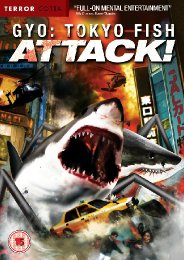





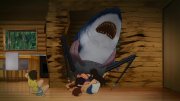
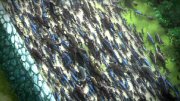
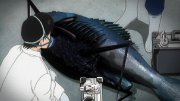

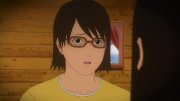





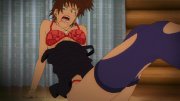
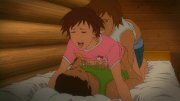


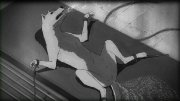
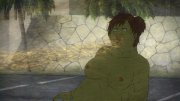
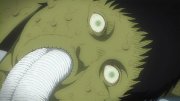


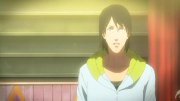

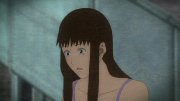

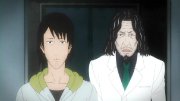








































Your Opinions and Comments
Be the first to post a comment!